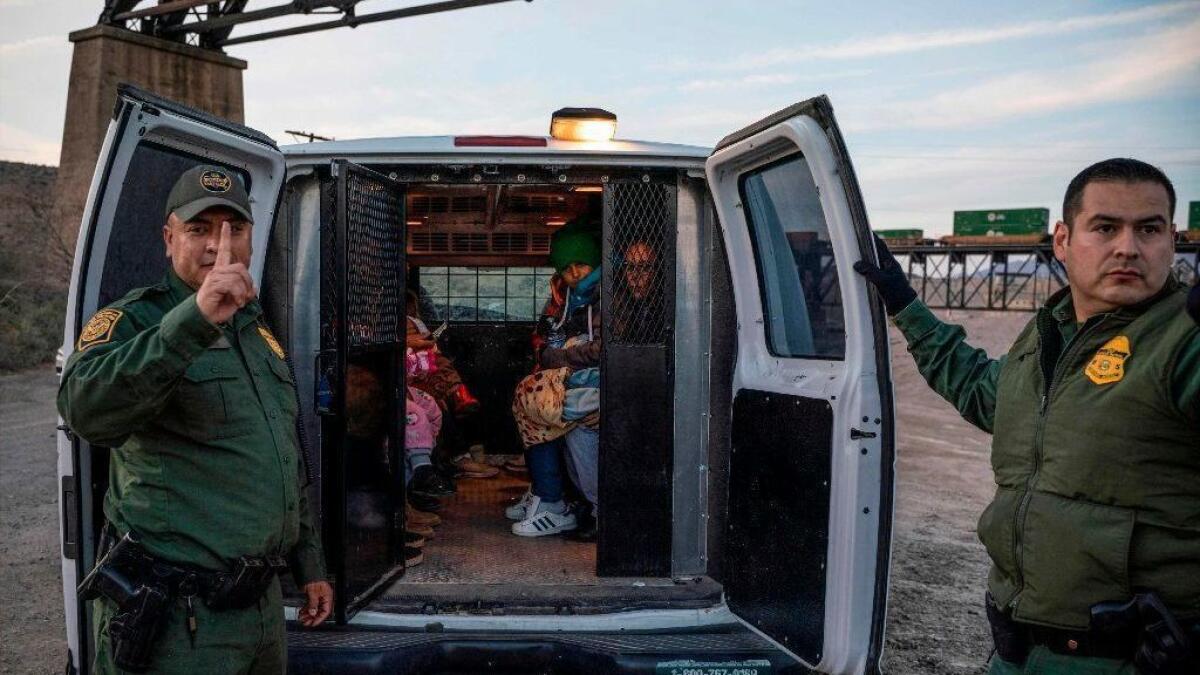Border Patrol will screen asylum requests in new push to restrict claims, memos show

Homeland Security officials are making it tougher for people seeking asylum to get over the first hurdle in the lengthy process of gaining U.S. protection, giving new power to Border Patrol agents and taking some discretion away from trained asylum officers, according to internal memos obtained by The Times.
The changes involve the initial interviews that asylum seekers go through to determine whether they have what U.S. law defines as a “credible fear” of being persecuted in their home country.
“The Asylum Division has been requested to conduct a training for Border Patrol agents in order to prepare them to conduct credible fear interviews,” John L. Lafferty, chief of the asylum division at U.S. Citizenship and Immigration Services, wrote in an email this week to headquarters and field office staff.
In a separate email, he reminded officers to focus on inconsistencies in asylum seekers’ claims when weighing their credibility, instructing them to be more adversarial in the initial interviews.
“I’d like to take this opportunity to remind officers of the requirement that credible fear applicants be asked to explain any statements made to [Customs and Border Protection] that appear to be inconsistent,” Lafferty wrote.
The new guidance is the latest in a series of steps the Trump administration has taken to try to deter people from applying for asylum or to find ways to reject their claims earlier in the process.
At campaign rallies and at the White House, President Trump often questions asylum seekers’ credibility, claiming that they’re engaging in a “hoax” or “big, fat con job.” He has lamented that Border Patrol and military personnel are restricted from getting “rough” with migrants.
At a rally Wednesday night in Panama City Beach, Fla., Trump noted Border Patrol can’t use weapons to deter migrants, and asked, “How do you stop these people?”
When someone yelled, “Shoot them!” the president smiled and replied, “That’s only in the Panhandle you can get away with that statement.”
In April, U.S. immigration authorities apprehended 98,977 people at the U.S.-Mexico border, the highest monthly total since 2007. Families and unaccompanied children from Central America, many of whom ask for asylum, made up the majority.
Most asylum applicants pass their initial credible fear screenings, but only about 20% ultimately win protection and the right to remain in the United States, according to the Justice Department. That final decision can take years, with a ballooning backlog of nearly 870,000 immigration cases and an average wait time of 736 days, according to a Syracuse University database, the Transactional Records Access Clearinghouse.
The administration points to the gap between the number passing the first step and the ultimate count of those getting asylum as evidence that many applicants are manipulating the system. Immigrant advocates argue that the law was written to make the initial credible fear test a lower standard in order to give asylum applicants a chance to make their case to an immigration judge. The fact that many ultimately can’t prove their case doesn’t mean claims are fraudulent, they say.
Leon Rodriguez, director of Immigration and Citizenship Services from 2014 to 2017, said he was “very uncomfortable” with the idea of Border Patrol agents conducting credible fear interviews.
“A person who is seeking asylum is likely to be somebody who has experienced a whole series of traumas,” Rodriguez said. “And to have a uniformed law enforcement officer being the one to conduct their credible fear interviews strikes me as calculated to suppress valid claims of asylum.”
In addition to having Border Patrol agents conduct some interviews, the new guidelines involve “important clarifications” and “numerous substantive changes,” Lafferty told asylum headquarters, managers and field staff.
Among the changes are removing an option to find applicants partially credible and requiring more extensive justification for deciding that an applicant’s fear claims are believable. Any inconsistencies or inability to provide more details must be weighed against an applicant, the memo said, even if applicants express fear of being removed from the United States or returned to their home country.
Citizenship and Immigration Services spokeswoman Jessica Collins described the guidance changes as part of a routine review to ensure that asylum officers’ training is in line with recent court decisions.
“Eliciting testimony and evaluating the credibility of any person making a fear claim in the expedited removal process is the key duty of any Asylum Officer,” Collins said in a statement. “This instruction is nothing new.”
Alan Bersin, who headed Customs and Border Protection under President Obama, said although there’s nothing remarkable about instructing asylum officers to use inconsistencies to assess credibility, the moves appear to be part of the Trump administration’s effort to “find means to limit the number of people who qualify for asylum and pass the credible fear test.”
Former officials and legislative staff suggested the new steps outlined in the memos could violate rules safeguarding the asylum process.
The administration recently asked Congress to approve an emergency funding request for the border that would include $23 million to train Border Patrol agents to do credible fear interviews.
The White House has also asked for more money for Border Patrol, saying it has been overwhelmed by the recent surge in migrants, though the agency has struggled with hiring and vacancies. It’s unclear how many agents could be spared for the additional asylum screening. Some agents have expressed frustration that caring for large groups of migrant children and families has pulled them away from law enforcement duties.
According to Lafferty’s memos, Border Patrol agents will first sit in on interviews with supervisors from the asylum division of Citizenship and Immigration Services, “and they will be required to show through their work that they have understood all applicable laws, regulations, policies, and procedures before being allowed to conduct interviews on their own.” As required by law, agents’ decisions will be reviewed by an experienced supervising asylum officer “before they are final,” he wrote.
Meanwhile, asylum officers also have expressed frustration at perceived pressure to disregard migrants’ fears of being returned home or removed to Mexico. Under a policy known as Remain in Mexico, officials have forced thousands of Central American asylum seekers to wait across the border while their cases are adjudicated in the United States.
On Tuesday, the U.S. 9th Circuit Court of Appeals in California ruled that the Trump administration can continue implementing the Remain in Mexico policy while challenges work their way through the courts. Two of the three judges on the panel, however, expressed concerns that the policy may violate asylum law.
“The government is wrong,” wrote Judge William Fletcher, appointed by President Clinton. “Not just arguably wrong, but clearly and flagrantly wrong.”
More to Read
Get the L.A. Times Politics newsletter
Deeply reported insights into legislation, politics and policy from Sacramento, Washington and beyond. In your inbox three times per week.
You may occasionally receive promotional content from the Los Angeles Times.







